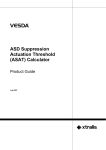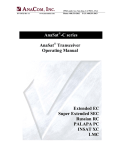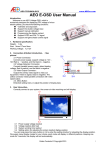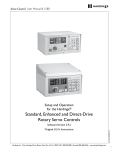Download Pico Repeater
Transcript
Pico Repeater User Manual (PRP-G1) User Manual of PRP-G1 GSM Pico Repeater Contents 1. Summary 2. System Configuration 2-1. System Operation 2-2. System Description 3. System Specifications 3-1. Electrical Specification 3-2. Mechanical Specification 4. Circuit Description 4-1. Forward Path (From BTS Towards Handset) 4-2. Reverse Path (From Handset Towards BTS) 5. System Block Diagram 6. Appearance 2/8 ASB lnc. 2004 User Manual of PRP-G1 GSM Pico Repeater 1. Summary The PRP-G1 Pico Repeater is an indoor and increases a call quality and coverage in RFshaded small area by boosting up and repeating the GSM RF signals so that it can improve a mobile service quality. It is suitable for the RF-shaded small area of any building or structure such as basement, house, and so on. All system specifications can be provided with minor modification for different GSM service frequencies. The system consists of a repeater unit with a link antenna and service antenna. 2. System Configuration 2-1. System Operation DONOR ANT. SERVICE ANT. 중계기 Repeater (Outdoor) 3/8 (Indoor) ASB lnc. 2004 User Manual of PRP-G1 GSM Pico Repeater 2-2. System Description A. External Configurations (1) In/Out Terminal: SMA Female (2) LED: To monitor the status of power on/off and normal operation (3) Power Supply Terminal: External type AC-DC power supply (Operating voltage: DC +8 V) (4) Gain Control Switch: 2-pin dipswitch, manual gain control (4, 8, 12 dB) B. Gain Control A user can control the forward and reverse gain manually by using 2-pin dipswitch up to 12 dB with the interval of 4 dB, as shown in the figure below. 1 2 1 2 1 2 1 2 ATT CTRL ATT 0dB ATT 4dB ATT 8dB ATT 12dB C. ASD (Auto Shut Down) Function The repeater has ASD function that controls its output power by real-time checking the signal output power of a forward path (BTS→Handset) and a reverse (Handset→BTS) path. If the output power of the path exceeds a maximum output power rating of the repeater, the DC power supply is automatically shut down to protect the circuits inside and a front LED turns to the red-colored to indicate a warning. 4/8 ASB lnc. 2004 User Manual of PRP-G1 GSM Pico Repeater 3. System Specifications 3-1. Electrical Specification Parameters Specifications System System Group Delay <5 ㎲ Self-generating Spurious Emission < -67 dBm / 30 KHz (@max. gain) Out Band Spurious Emission < -36 dBm @ 9 KHz ~ 1 GHz < -30 dBm @ 1 GHz ~ 12.75 GHz Pass Band Ripple 4 dB (peak to peak) Noise Figure < 10 dB Tx/Rx Isolation > 65 dB Characteristic Impedance 50 ohm Input VSWR 1.5 : 1 Forward Path (BTS towards Handset) Gain 50 dB Max. (Att. step 4 dB, range 12 dB) Frequency Range 890 MHz~915 MHz Input Power Range < -45 dBm / Total Maximum Output Power 0 dBm Max. / Total Reverse Path (Handset towards BTS) 5/8 Gain 50 dB Max. (Att. step 4 dB, range 12 dB) Frequency Range 935 MHz~960 MHz Input Power Range < -45 dBm / Total Maximum Output Power 5 dBm Max. / Total ASB lnc. 2004 User Manual of PRP-G1 GSM Pico Repeater 3-2. Mechanical Specification 6/8 Parameters Standards Dimension 104 mm X 64 mm X 42 mm (H X W X D) Weight 550 g Power Supply AC-DC (+8 V) External Power Supply Adapter Operating Temperature/Humidity -5 ~ +50 °C / 5% ~ 95% Power Consumption <6W Input/Output Connector Type SMA Female Radio type G7W, D7W Communication Method Duplex Communication ASB lnc. 2004 User Manual of PRP-G1 GSM Pico Repeater 4. Circuit Description The input/output connector of the repeater is SMA Female type and a communication method is Duplex Communication. The power supply is AC-DC (+8 V) external power supply adapter. 4-1. Forward Path (BTS towards Handset) A signal from the BTS is received through the donor antenna of the repeater and the received input signal is isolated from a transmitter by a duplexer. This isolated signal is lownoise amplified and then it passes a variable attenuator. Then it is amplified at a second stage and prior to final stage amplification the signal is filtered by a band-pass filter. The output signal from the final amplifier is transmitted through the duplexer towards the service antenna. A directional coupler monitors the output power level of the transmitting signal and activates the ASD function if exceeding the maximum output power. 4-2. Reverse Path (Handset towards BTS) The circuit of the reverse path is the same as that of the forward path. The signal from the mobile handset is received by the service antenna of the repeater and transmitted through the donor antenna. The directional coupler does the same way to provide the ASD function in the reverse path. 7/8 ASB lnc. 2004 User Manual of PRP-G1 GSM Pico Repeater 5. System Block Diagram 6. Appearance 전원 (POWER) 장애 (WARNING) 8/8 ASB lnc. 2004
















